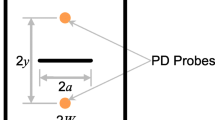Abstract
The objective of this paper is to develop the load separation method for evaluating the ηpl and ηpl CMOD plastic factors used in the J estimation approach based on load versus displacement records. Appropriate forms for the geometry and deformation functions have been suggested from the EPRI Handbook solutions to produce the separable form for the load. The obtained functions are applied to evaluate the ηpl and ηpl CMOD plastic factors for center cracked tension specimen. The present load separation method gave results which are somewhat different from the estimated values of ηpl given in the literature. For shallow cracks, the ηpl and ηCMOD pl plastic factors show considerable variation with crack size and the strain hardening exponent. For a deeply cracked CCT specimen, the ηCMOD pl factor tends to the ηpl factor and equals approximately unity.
Abbreviations: CCT – center cracked specimen; CMOD – Crack Mouth Opening Displacement; EPRI – Electric Power Research Institute; FEM – Finite Element Method; LLD – Load Line Displacement.
Similar content being viewed by others
References
Anderson, T.L. (1995). Fracture Mechanics: Fundamentals and Applications. CRC Press, Boca Raton.
Cassanelli, A.N., Cocco, R. and de Vedia, L.A. (2003). Separability property and ç pl factor in ASTM A387-Gr22 steel plate. Engineering Fracture Mechanics 70, 1131–1142.
Joyce, J.A., Hackett, E.M. and Roe, C. (1992). Comparison of J IC and J R Curves for Short Crack and Tensilely Loaded Specimen Geometries of a High Strength Steel. NUREG/CR-5879, US Nuclear Regulatory Commission, Washington.
Hutchinson, W. (1968). Singular behavior of the end of a tensile crack in hardening materials. Journal of Mechanics and Physics of Solids 16, 13–31.
Kim, Y.-J. and Schwalbe, K.-H. (2001). On the sensitivity of J estimation to materials' stress-strain curves in fracture toughness testing using the finite element method. Journal of Testing and Evaluation 29, 18–30.
Kim, Y.-J., Kim, J.-S., Cho, S.-M. and Kim, Y.-J. (2004). 3-D constraint effects on J testing and crack tip constraint in M(T), SE(B), SE(T) and C(T) specimens: numerical study. Engineering Fracture Mechanics 71, 1203–1218.
Kirk, M.T. and Dodds, R.H. (1993). J and CTOD estimation equations for shallow cracks in single edge notch bend specimens. Journal of Testing and Evaluation 21, 228–238.
Kumar, V., German, M.D. and Shih, C.F. (1981). An Engineering Approach for Elastic-Plastic Fracture Analysis. Report EPRI NP-1931, Electric Power Research Institute, Palo Alto.
Lei, Y. and Ainsworth, R.A. (1997). The estimation of J in three-point-bend specimens with a crack in a mismatched weld. International Journal of Pressure Vessels and Piping 70, 247–257.
Matvienko, Yu.G. (1994). J-estimation formulas for non-linear crack problems. International Journal of Fracture 68, R15–R18.
Matvienko, Yu.G. (1997). Aproximate solution for hardening solids with a crack. Recent Advances in Fracture. (Edited by R.K. Mahidhara, A.B. Geltmacher, K. Sadananda and P. Matic) TMS publ. Warrendale, 307–313.
O'Dowd, N.P., Kolednik, O. and Naumenko, V.P. (1999). Elastic-plastic analysis of biaxially loaded center-cracked plates. International Journal of Solids and Structures 36, 5639–5661.
Paris, P.C., Ernst, H. and Turner, C.E. (1980). A J-integral approach to development of ç-factors. In Fracture Mechanics: Twelfth Conference, ASTM STP 700. American Society for Testing and Materials. Philadelphia, pp. 338–351.
Rice, J.R. and Rosengren, G.F. (1968). Plane strain deformation near a crack tip in a power-law hardening materials. Journal of Mechanics and Physics of Solids 16, 1–12.
Rice, J.R., Paris, P.D. and Merkle, J.G. (1973). Some further results of J-integral analysis and estimates. In Progress in Flaw Growth and Fracture Toughness Testing, ASTM STP 536. American Society for Testing and Materials. Philadelphia, pp. 231–245.
Schwalbe, K.-H. and Zerbst, U. (2000). The engineering treatment model. International Journal of Pressure Vessels and Piping 77, 905–918.
Sharobeam, M.H. and Landes, J.D. (1991). The load separation criterion and methodology in ductile fracture mechanics. International Journal of Fracture 47, 81–104.
Sharobeam, M.H. and Landes, J.D. (1993). A simplified approach for ductile failure analysis of semi-elliptical surface cracks. International Journal of Fracture 61, 379–395.
Sharobeam, M.H. and Landes, J.D. (1999). Numerical solutions for ductile behaviour of semi-elliptical surface crack. Engineering Fracture Mechanics 63, 131–145.
Sreenivasan, P.R. and Mannan, S.L. (2000). Plastic ç-factor for three-point bend specimens: analysis of instru-mented Charpy impact test results for AISI 308 weld and AISI 316 stainless steels. International Journal of Fracture 101, 215–228.
Sumpter, J.D.G. and Turner, C.E. (1976). Method for laboratory determination of J c.InCracks and Fracture, ASTM STP 601. American Society for Testing and Materials. Philadelphia, pp. 266–287.
Wilson, C.D. and Mani, P. (2002). Plastic J-integral calculations using the load separation method for the center cracked tension specimen. Engineering Fracture Mechanics 69, 887–898.
Wu, S.-X., Mai, Y.-W. and Cotterell, B. (1990). Plastic ç-factor (ç p )of fracture specimens with deep and shallow cracks. International Journal of Fracture 45, 1–18.
Author information
Authors and Affiliations
Rights and permissions
About this article
Cite this article
Matvienko, Y. Separable functions in load separation for the ηpl and ηpl CMOD plastic factors estimation. International Journal of Fracture 129, 265–278 (2004). https://doi.org/10.1023/B:FRAC.0000047785.02563.c3
Issue Date:
DOI: https://doi.org/10.1023/B:FRAC.0000047785.02563.c3




